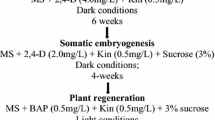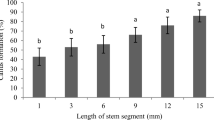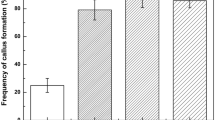Abstract
Sub-apical slices and leaf-roll explants of sugarcane (Saccharum hybrids) cv. B.O. 91 formed callus on Murashige and Skoog’s (MS) basal medium supplemented with 5 mg/1 2,4-dichlorophenoxyacetic acid (2,4-D). Callus was maintained on 3 mg/1 2,4-D augmented medium. Concentrations of 2,4-D resulted in differences in growth rate and morphogenetic patterns. Rapid regeneration via somatic embryogenesis was obtained on 1 mg/1 kinetin. 0.5-2.0 cm tall shoots were obtained within 4 weeks on Kn containing medium, however, the root growth remained suppressed. The resulting shoots were rooted on 1/2 strength basal medium (sucrose @ 20 g/l) supplemented with 0.2 mg/l α-naphthalene acetic acid (NAA). Within 5 weeks healthy plantlets (12.2 ± 1.8 cm) bearing 14.3 ± 7.3 roots were obtained on rooting medium. These were successfully established in soil following a 3 week hardening phase. The procedure holds promise for genetic manipulation via cellular/molecular breeding in this cultivar.
Similar content being viewed by others
References
Barba, R. and Nickell, L.G. (1969). Nutrition and organ differentiation in tissue cultures of sugarcane, a monocotyledon.Planta,89: 299–302.
Chen, W.H., Davey, M.R., Power, J.B. and Cocking, E.C. (1988). Sugarcane protoplasts: Factors affecting division and plant regeneration.Plant Cell Rep.,7: 344–347.
Fitch, M.M.M. and Moore, P.H. (1990). Comparision of 2,4-D and Picloram for selection of long-term totipotent callus cultures of sugarcane.Plant Cell Tissue and Organ Culture,20: 157–163.
Heinz, D.J. and Mee, G.W.P. (1969). Plant differentiation from callus tissue ofSaccharum species.Crop Sci.,9: 346–348.
Ho, W.J. and Vasil, I.K. (1980). Somatic embryogenesis in sugarcane (Saccharum officinarum L.): Morphology and physiology of callus formation and ontogeny of somatic embryos.Protoplasma,118: 169–180.
Lu, C. and Vasil, I.K. (1981). Somatic embryogenesis and plant regeneration from freely-suspended cells and cell groups ofPanicum maximum Jacq.Ann. Bot.,48: 543–548.
Murashige, T. and Skoog, F. (1962). A revised medium for rapid growth and bioassays with tobacco tissue cultures.Physiol. Plant.,15: 473–497.
Sankarnarayanan, R., Natrajan, B.V. and Subramanian, K. (1987). Sugarcane varieties in India (1979–1986). Sugarcane Breeding Institute, Coimbatore (India) Publication, p. 206.
Vasil, I.K. (1983). In Lurquin, P. and Kieinhofs, A. (eds.) Genetic engineering in Eukaryotes. Plenum Press, New York, p. 233.
Vasil, V. and Vasil, I.K. (1981). Isolation and culture of cereal protoplasts: II. Embryogenesis and plantlet formation from protoplasts of Pearl millet (Pennisetum americanum).Theor. Appl. Genet.,56: 97–99.
Author information
Authors and Affiliations
Corresponding author
Rights and permissions
About this article
Cite this article
Lal, N. High frequency plant regeneration from sugarcane callus. Sugar Tech 5, 89–91 (2003). https://doi.org/10.1007/BF02943773
Published:
Issue Date:
DOI: https://doi.org/10.1007/BF02943773




